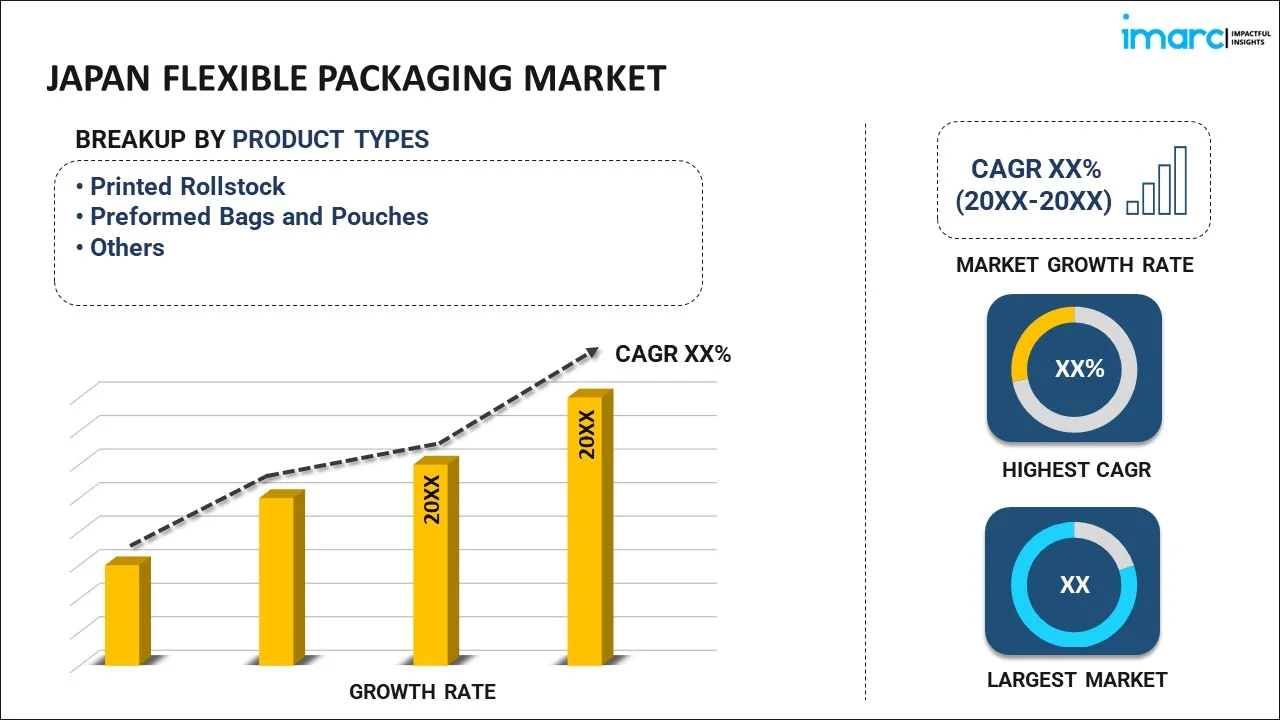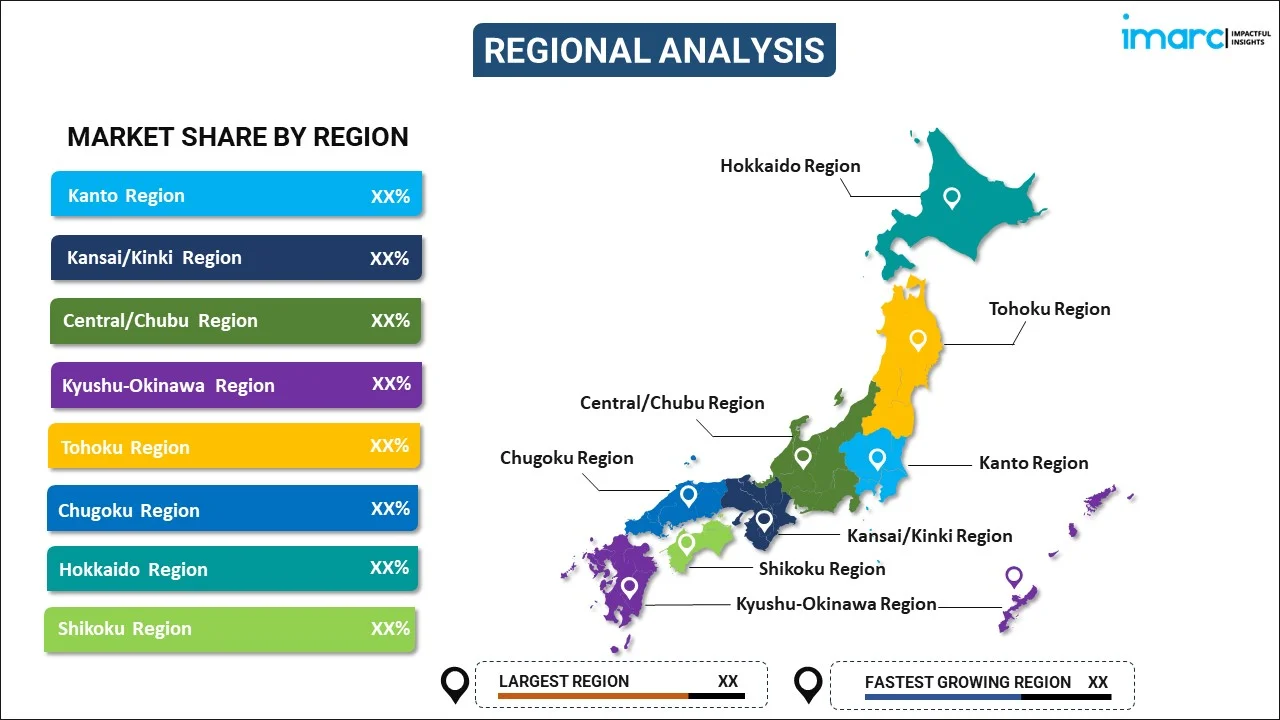
Japan Flexible Packaging Market Report by Product Type (Printed Rollstock, Preformed Bags and Pouches, and Others), Raw Material (Plastic, Paper, Aluminium Foil, Cellulose), Printing Technology (Flexography, Rotogravure, Digital, and Others), Application (Food and Beverages, Pharmaceuticals, Cosmetics, and Others), and Region 2025-2033
Market Overview:
Japan flexible packaging market size reached USD 8.5 Billion in 2024. Looking forward, IMARC Group expects the market to reach USD 14.7 Billion by 2033, exhibiting a growth rate (CAGR) of 6.2% during 2025-2033. The shifting consumer preferences, such as the demand for convenient, on-the-go, and portion-controlled products, which have fueled the need for flexible packaging solutions, is driving the market.
|
Report Attribute
|
Key Statistics
|
|---|---|
|
Base Year
|
2024 |
|
Forecast Years
|
2025-2033 |
|
Historical Years
|
2019-2024
|
| Market Size in 2024 | USD 8.5 Billion |
| Market Forecast in 2033 | USD 14.7 Billion |
| Market Growth Rate (2025-2033) | 6.2% |
Flexible packaging refers to a versatile and lightweight packaging solution that can be easily shaped and molded to accommodate various products. It typically involves the use of materials such as plastic, aluminum foil, and paper, which can be manipulated and adjusted to create pouches, bags, or wraps. This type of packaging offers several advantages, including cost-effectiveness, reduced transportation costs due to its lightweight nature, and the ability to extend product shelf life through improved barrier properties that protect against moisture, oxygen, and other external elements. Flexible packaging is widely utilized in the food and beverage industry, as well as in pharmaceuticals, personal care products, and other consumer goods. Its adaptability and customizable design make it a popular choice for manufacturers aiming to enhance product visibility and consumer convenience while minimizing environmental impact through options for recyclability and sustainability.
Japan Flexible Packaging Market Trends:
The flexible packaging market in Japan is witnessing robust growth, primarily driven by various factors. Firstly, the escalating demand for convenient and lightweight packaging solutions is propelling market expansion. Consequently, this led to an increased preference for flexible packaging among consumers and manufacturers alike. Additionally, the surging emphasis on sustainable and eco-friendly packaging materials is fostering innovation within the market, thereby bolstering its growth trajectory. As a result, manufacturers are increasingly investing in R&D to introduce biodegradable and recyclable packaging alternatives, catering to the growing environmental concerns. Moreover, the burgeoning food and beverage industry, coupled with the rapid expansion of the e-commerce sector, is fueling the demand for flexible packaging solutions. This trend is attributed to the ability of flexible packaging to offer enhanced product protection, extended shelf life, and improved aesthetic appeal, meeting evolving consumer preferences. Furthermore, the cost-effectiveness and versatility of flexible packaging materials are driving their adoption across various end-use industries, including pharmaceuticals, personal care, and industrial sectors, contributing significantly to the expansion of the market. In light of these drivers, the flexible packaging market in Japan is poised to experience substantial growth in the coming years.
Japan Flexible Packaging Market Segmentation:
IMARC Group provides an analysis of the key trends in each segment of the market, along with forecasts at the country level for 2025-2033. Our report has categorized the market based on product type, raw material, printing technology, and application.
Product Type Insights:

- Printed Rollstock
- Preformed Bags and Pouches
- Others
The report has provided a detailed breakup and analysis of the market based on the product type. This includes printed rollstock, preformed bags and pouches, and others.
Raw Material Insights:
- Plastic
- Paper
- Aluminium Foil
- Cellulose
A detailed breakup and analysis of the market based on the raw material have also been provided in the report. This includes plastic, paper, aluminium foil, and cellulose.
Printing Technology Insights:
- Flexography
- Rotogravure
- Digital
- Others
The report has provided a detailed breakup and analysis of the market based on the printing technology. This includes flexography, rotogravure, digital, and others.
Application Insights:
- Food and Beverages
- Pharmaceuticals
- Cosmetics
- Others
A detailed breakup and analysis of the market based on the application have also been provided in the report. This includes food and beverages, pharmaceuticals, cosmetics, and others.
Regional Insights:

- Kanto Region
- Kansai/Kinki Region
- Central/ Chubu Region
- Kyushu-Okinawa Region
- Tohoku Region
- Chugoku Region
- Hokkaido Region
- Shikoku Region
The report has also provided a comprehensive analysis of all the major regional markets, which include Kanto Region, Kansai/Kinki Region, Central/ Chubu Region, Kyushu-Okinawa Region, Tohoku Region, Chugoku Region, Hokkaido Region, and Shikoku Region.
Competitive Landscape:
The market research report has also provided a comprehensive analysis of the competitive landscape. Competitive analysis such as market structure, key player positioning, top winning strategies, competitive dashboard, and company evaluation quadrant has been covered in the report. Also, detailed profiles of all major companies have been provided.
Japan Flexible Packaging Market Report Coverage:
| Report Features | Details |
|---|---|
| Base Year of the Analysis | 2024 |
| Historical Period | 2019-2024 |
| Forecast Period | 2025-2033 |
| Units | Billion USD |
| Scope of the Report | Exploration of Historical and Forecast Trends, Industry Catalysts and Challenges, Segment-Wise Historical and Predictive Market Assessment:
|
| Product Types Covered | Printed Rollstock, Preformed Bags and Pouches, Others |
| Raw Materials Covered | Plastic, Paper, Aluminium Foil, Cellulose |
| Printing Technologies Covered | Flexography, Rotogravure, Digital, Others |
| Applications Covered | Food and Beverages, Pharmaceuticals, Cosmetics, Others |
| Regions Covered | Kanto Region, Kansai/Kinki Region, Central/ Chubu Region, Kyushu-Okinawa Region, Tohoku Region, Chugoku Region, Hokkaido Region, Shikoku Region |
| Customization Scope | 10% Free Customization |
| Post-Sale Analyst Support | 10-12 Weeks |
| Delivery Format | PDF and Excel through Email (We can also provide the editable version of the report in PPT/Word format on special request) |
Key Questions Answered in This Report:
- How has the Japan flexible packaging market performed so far and how will it perform in the coming years?
- What has been the impact of COVID-19 on the Japan flexible packaging market?
- What is the breakup of the Japan flexible packaging market on the basis of product type?
- What is the breakup of the Japan flexible packaging market on the basis of raw material?
- What is the breakup of the Japan flexible packaging market on the basis of printing technology?
- What is the breakup of the Japan flexible packaging market on the basis of application?
- What are the various stages in the value chain of the Japan flexible packaging market?
- What are the key driving factors and challenges in the Japan flexible packaging?
- What is the structure of the Japan flexible packaging market and who are the key players?
- What is the degree of competition in the Japan flexible packaging market?
Key Benefits for Stakeholders:
- IMARC’s industry report offers a comprehensive quantitative analysis of various market segments, historical and current market trends, market forecasts, and dynamics of the Japan flexible packaging market from 2019-2033.
- The research report provides the latest information on the market drivers, challenges, and opportunities in the Japan flexible packaging market.
- Porter's five forces analysis assist stakeholders in assessing the impact of new entrants, competitive rivalry, supplier power, buyer power, and the threat of substitution. It helps stakeholders to analyze the level of competition within the Japan flexible packaging industry and its attractiveness.
- Competitive landscape allows stakeholders to understand their competitive environment and provides an insight into the current positions of key players in the market.
Need more help?
- Speak to our experienced analysts for insights on the current market scenarios.
- Include additional segments and countries to customize the report as per your requirement.
- Gain an unparalleled competitive advantage in your domain by understanding how to utilize the report and positively impacting your operations and revenue.
- For further assistance, please connect with our analysts.
 Inquire Before Buying
Inquire Before Buying
 Speak to an Analyst
Speak to an Analyst
 Request Brochure
Request Brochure
 Request Customization
Request Customization




.webp)




.webp)












